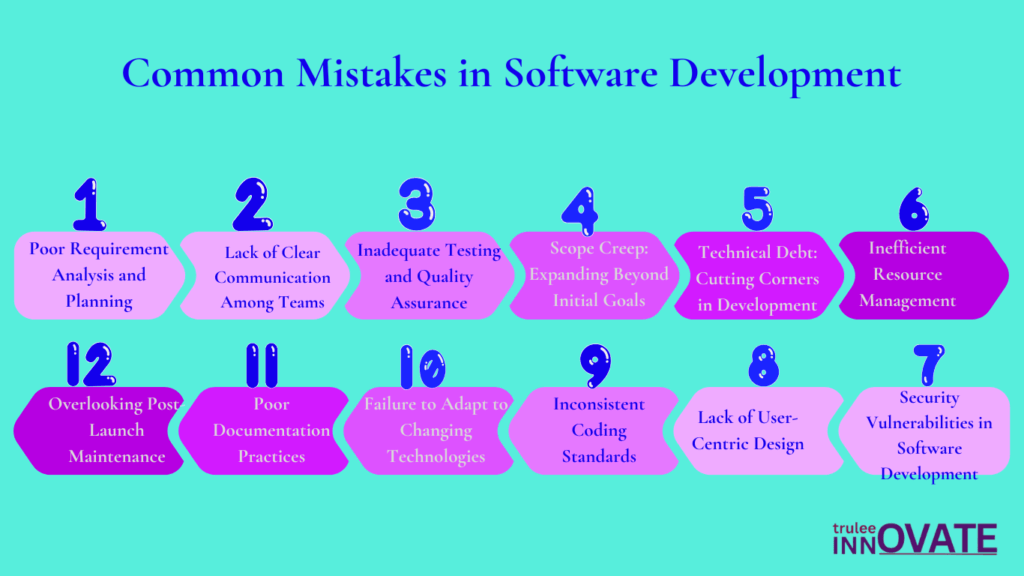Software Development is a complex and dynamic process that requires precision, collaboration, and adaptability. However, even the most experienced developers and companies encounter software development problems that can derail projects, increase costs, and frustrate stakeholders. In this blog, we’ll explore the most common software development challenges, their root causes, and actionable strategies to avoid them. Whether you’re a developer, project manager, or business owner, this guide will help you navigate the complexities of the software development process and achieve better outcomes
1. Introduction to Software Development Problems
Every software development project comes with its own set of challenges. From planning to deployment, there are numerous opportunities for things to go wrong. Software development problems can range from minor bugs to major system failures, and they often stem from common mistakes in software development. These issues not only delay timelines but also impact the quality and functionality of the final product. By understanding these challenges and implementing proactive measures, teams can minimize risks and deliver successful projects.
Common Mistakes in Software Development
One of the primary reasons for software development problems is the recurrence of common software development mistakes. These errors often occur due to a lack of experience, poor planning, or inadequate communication. For example, skipping the testing phase or failing to document code can lead to common software errors that are difficult to fix later. Recognizing these mistakes early on is crucial for avoiding costly setbacks.
1. Poor Requirement Analysis and Planning
For every project to be successful, a strong foundation is necessary. Unfortunately, many teams underestimate the importance of thorough requirement analysis and planning. This oversight often leads to software development challenges such as missed deadlines, budget overruns, and unsatisfied clients. To avoid this, invest time in understanding the project’s goals, gathering detailed requirements, and creating a realistic timeline. Tools like user stories and wireframes can help clarify expectations and ensure alignment among stakeholder
2. Lack of Clear Communication Among Teams
Any software development project that is successful is built on effective communication. However, miscommunication or lack of communication is one of the most common software development problems. When developers, designers, and project managers are not on the same page, it can result in common software errors, duplicated efforts, and delays. Implementing regular stand-up meetings, using collaboration tools, and maintaining open channels of communication can significantly reduce these issues.
3. Inadequate Testing and Quality Assurance
Testing is a critical phase in the software development process, yet it is often rushed or overlooked. Inadequate testing can lead to types of software problems such as bugs, crashes, and security vulnerabilities. To ensure a high-quality product, teams should adopt a comprehensive testing strategy that includes unit testing, integration testing, and user acceptance testing. Automated testing tools can also help streamline the process and catch errors early.
4. Scope Creep: Expanding Beyond Initial Goals
Scope creep occurs when a project’s requirements expand beyond the original plan, often due to changing client demands or unclear objectives. This is one of the biggest risks in software development, as it can lead to missed deadlines, increased costs, and team burnout. To prevent scope creep, establish a clear project scope from the beginning and use change management processes to evaluate and approve any new requests.
5. Technical Debt: Cutting Corners in Development
Technical debt refers to the shortcuts taken during development to meet deadlines or reduce costs. While these shortcuts may provide short-term benefits, they often result in software development problems down the line, such as poor performance and difficult-to-maintain code. To manage technical debt, prioritize refactoring, adhere to coding standards, and allocate time for regular code reviews.
6. Inefficient Resource Management
Resource management is a key factor in the success of any software development project. Poor allocation of resources, whether it’s time, money, or personnel, can lead to common software development mistakes and project failures. To optimize resource management, use project management tools, track progress regularly, and ensure that team members have the skills and tools they need to succeed.
7. Security Vulnerabilities in Software Development
Security is often an afterthought in the software development process, but it should be a top priority. Ignoring security can result in software problems and solutions such as data breaches, loss of customer trust, and legal consequences. To mitigate these risks, integrate security practices into every phase of development, conduct regular security audits, and stay updated on the latest threats and vulnerabilities.
8. Lack of User-Centric Design
A successful software product must meet the needs of its users. However, many teams focus too much on technical aspects and neglect user experience. This can lead to common software errors and low user satisfaction. To avoid this, involve users in the design process, conduct usability testing, and prioritize features that add value to the end-user.
9. Inconsistent Coding Standards
Inconsistent coding practices can create software development challenges such as difficult-to-maintain code and increased risk of errors. Establishing and enforcing coding standards is essential for maintaining code quality and ensuring that all team members are on the same page. Code reviews and automated linting tools can help enforce these standards.
10. Failure to Adapt to Changing Technologies
The tech industry evolves rapidly, and failing to keep up with new technologies can put your project at a disadvantage. This is one of the common software development mistakes of software companies. To stay competitive, invest in continuous learning, experiment with new tools and frameworks, and encourage innovation within your team.
11. Poor Documentation Practices
Documentation is often seen as a tedious task, but it plays a crucial role in solving software development problems. Poor documentation can lead to confusion, wasted time, and errors. To improve documentation practices, create clear and concise documents, update them regularly, and make them easily accessible to all team members.
12. Overlooking Post-Launch Maintenance
The work doesn’t end once the software is launched. Post-launch maintenance is essential for addressing software problems and solutions such as bugs, performance issues, and user feedback. To ensure long-term success, allocate resources for ongoing maintenance and establish a process for handling updates and fixes.

What Are the 10 Biggest Risks in Software Development?
Understanding the 10 biggest risks in software development can help you prepare for potential challenges. These risks include poor requirement analysis, inadequate testing, scope creep, security vulnerabilities, and more. By identifying and addressing these risks early, you can minimize their impact and ensure a smoother development process.
Best Practices to Avoid Software Development Problems
To overcome software development challenges, adopt best practices such as thorough planning, effective communication, regular testing, and continuous improvement. By learning from common software development mistakes and implementing proven strategies, you can deliver high-quality software that meets user expectations.
Conclusion: Turning Challenges into Opportunities
Software development problems are inevitable, but they don’t have to derail your project. By understanding the most common software development challenges and implementing proactive measures, you can turn these challenges into opportunities for growth and innovation. Remember, the key to success lies in thorough planning, effective communication, and a commitment to continuous improvement.


